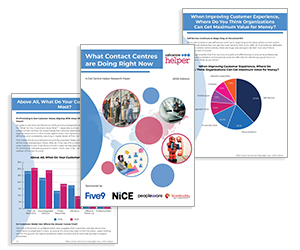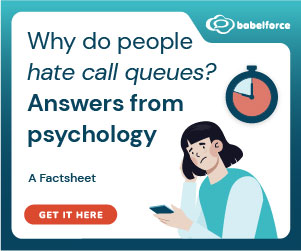Chris Dealy at Peopleware explains how to separate the myths from the realities of contact centre AI, what it really means for agents and workforce planning, and how to maximise its benefits while avoiding costly missteps.
Organizations that have rushed into contact centre AI have experienced unsuccessful and expensive proofs-of-concept, stalled pilots, and disillusionment with the entire topic of AI.
Many myths are circulating about the costs and benefits of AI. Now that the dust is settling after the initial scramble to bring AI into the contact centre, let’s try to establish some rules of thumb for maximizing the benefit and minimizing the disruption of contact centre AI.
Artificial Intelligence (AI) has existed as a concept since the 1950s. In 2022, with the launch of generative AI platforms like ChatGPT, DALL-E, and Midjourney, AI went mainstream.
Now, every contact centre technology vendor has jumped on the AI bandwagon, and it seems that no product is complete unless it is packed with “AI” features.
AI certainly has the potential to improve the customer experience, enhance the working lives of agents, drive up productivity, and unlock cost savings.
We explore how AI can help contact centres enhance customer experience in this blog. But there’s no such thing as a free lunch.
AI has been characterized as the 4th industrial revolution, disrupting businesses in every industry sector. contact centre leaders are feeling the pressure to adopt AI.
It’s easy to develop a fear of missing out, a feeling that if you don’t start using AI, you will fall behind your competitors.
You Need to be Realistic About Which Queries Can be Handled by AI
Despite the claims of the software vendors, anyone who has tried to use customer service AI chatbots will have formed a strong impression that AI can’t yet handle any conceivable customer interaction.
What’s more, if bots and other AI customer service tools prove incapable of helping, customers lose faith in them and try to find ways to immediately bypass the bot, which defeats the object of implementing AI in the first place.
In most countries, the millennial generation, generation Z and generation X make up the majority of the customer population. These generations are digital natives.
They prefer to solve problems on a self-service basis and only reach out to the contact centre as a last resort. It follows that if such customers can’t solve a problem themselves, AI will also struggle to solve it.
Even the latest natural language AI systems can fail to correctly interpret customer intent, partly because customers sometimes struggle to express their problem clearly, completely, and succinctly.
It’s also important to remember that your website isn’t the only source of customer service information. Customers are very likely to use Google, with its Gemini AI engine, to find answers before visiting your website.
They may use other third-party AI tools such as ChatGPT to find answers. Unless your own AI can answer complex questions better than Google or ChatGPT, your investment is wasted, and your reputation will suffer.
Assuming that AI can solve any customer problem risks damaging your organization’s reputation and can be costly, as Air Canada recently learned.
The airline used AI to provide passenger information. The only problem was that the AI ‘hallucinated’ information about discounts, and a passenger took them to court about it.
Air Canada argued that it could not be held responsible for this, but the court disagreed and awarded damages to affected passengers.
Human Call Centre Agents Will Always be Indispensable
Nobody would dispute that customer service AI can handle certain categories of customer queries automatically and thus reduce the workload for human agents.
And AI tools can help agents to be more productive, improving the quality and consistency of their work. A PwC report reveals three times higher growth in revenue per worker in industries (such as contact centres) that are more exposed to AI.
Of course, contact centre self-service isn’t new. Interactive Voice Response (IVR) has enabled customers to get information such as account balances, opening times, and renewal dates for many years.
AI has made it possible for customers to interact with the automation using natural language, which is quicker and, in theory, easier.
But it is dangerous to assume that contact centre AI will ever completely eliminate the need for human agents. Based on the assumption that most human interactions can be replaced with AI, some organizations slashed their agent headcount and stopped hiring as soon as AI was implemented.
For example, after boasting about reducing headcount by over 1,000 as a result of implementing contact centre AI, Swedish fintech company Klarna admitted that over-use of AI had damaged the quality of customer service and started hiring people again.
A Gartner poll revealed that 50% of contact centres that had expected to drastically cut their agent count by using AI will abandon these plans in 2025.
The poll also revealed that 95% of contact centre managers plan to retain human agents, adopting a ‘digital first, but not digital only’ strategy.
There are solid reasons why human agents will always be needed, even when contact centre AI becomes ubiquitous. AI is perfect for handling routine queries.
But complex queries are often beyond the capabilities of bots. When this happens, customers begin to hate bots. Customers are not machines, and they don’t want to be treated like machines.
Until the day that you are 100% confident that your AI bots can handle any conceivable query, you must make it easy for your customers to speak to a human agent.
Many customer interactions will always require human empathy, critical thinking, and judgment. For example, in complaints, retention, and collections.
It’s hard to imagine a bot building sufficient rapport with a complaining customer to convince them to renew their contract.
It’s important to remember that AI isn’t free. There are software fees. Contact centre AI needs setup and maintenance. That means you’ll need people in your organization who are skilled in managing AI software, with job titles like AI trainer, conversation designer, and bot supervisor.
A PwC report revealed a 56% wage premium for employees with AI skills. Introducing AI will incur costs that you didn’t previously need to budget for.
In reality, there is little evidence that contact centre AI will lead to the elimination of human agents from contact centres. AI is primarily about changing agent roles, not making every agent redundant.
The challenge is to find the optimum mix of AI and human interaction, enabling humans to focus on those customer interactions where they can add value. And you’ll need to help agents make the transition from roles that AI can handle to roles that AI can’t.
Many Contact Centres Are Not AI-Ready
Unlike some previous innovations, contact centre AI is not ‘plug and play’. Trying to bolt it onto your existing operation without proper preparation is a recipe for disaster.
For contact centre AI to have a chance of being successful, you need to make sure your data and your organization are AI-ready.
Data
AI is only as good as the data that you can provide for the AI to learn from. Every organization stores huge volumes of data that AI needs to help customers.
The problem is that it may not be stored in a form that the AI can use. Data may be stored in databases, spreadsheets, Word documents, Slack threads, emails and PDFs. It can be stored on in-house servers or in the cloud.
According to Forbes, “If AI is the future, then data is the terrain. And most businesses are hiking in flip-flops”. Gartner predicts that 60% of AI projects will be abandoned because AI-ready data isn’t available.
What’s more, 63% of organizations either don’t have AI-compatible data management practices or don’t know if they have them.
The same thinking applies to workforce management (WFM). The best WFM tools now use machine learning AI to generate forecasts to very high levels of accuracy with very low human effort.
But to do this, they need access to months or years of historical data, free of data gaps and anomalies. Just as importantly, they need to be fed with business intelligence about factors that impact the forecast that historical data doesn’t predict.
In practice, this means a human planner proactively gathering information about upcoming product launches, pricing changes, marketing campaigns, and more, then exposing this knowledge to the AI.
Organization
The business case for implementing contact centre AI is mainly about cost reduction. To put it bluntly, the cost reduction arises by displacing agents who previously handled customer interactions that are now handled by AI.
The jury is out about the extent to which this is possible or desirable. But every contact centre has a finite budget. Spending more money on AI means there is less to spend elsewhere.
With personnel costs historically accounting for over 70% of the typical contact centre budget, reductions in headcount will inevitably be necessary to pay for AI.
It’s not as simple as just reducing headcount. If AI handles the simpler queries, the remaining queries will be complex, which means your remaining agents will need to be even more skilled and probably better paid. You may also be well-advised to reorganize your contact centre.
Instead of having large groups of agents handling homogeneous, routine queries, it may make sense to organize your agents into teams that specialize in the different complex, high-value, or emotionally-charged interactions.
To maximize efficiency, you should explore the feasibility of implementing multi-skilling. And as AI blurs the boundaries between self-service, front office, and back office, the contact centre may become part of a ‘customer experience hub’.
AI Makes Workforce Planning Harder, Not Easier
If the purpose of contact centre AI is to reduce headcount, it would seem logical to assume that a side effect of implementing AI is that the workforce planning process becomes simpler.
Smaller workforce = easier workforce planning, right? WFM professionals know that the reverse is likely to be true, for several reasons.
Forecasting for small volumes means the data is likely to be more ‘noisy’, so normal random variations have a bigger impact.
This makes it more difficult to maintain consistent occupancy and service levels. Seasonal trends and patterns are more difficult to detect with low volumes.
When agents are handling the complex interactions that AI can’t cope with, the average handling time (AHT) is likely to be longer, possibly much longer. And AHT is also likely to be more volatile. That all makes forecasting, planning, and real-time management more challenging.
In a large contact centre, you have ‘safety in numbers’. With a larger workforce, it’s easier to find people willing to work early and late shifts.
It’s simpler to maintain coverage throughout the entire day by staggering breaks and lunches. The absence of a single agent doesn’t make much difference in a large contact centre. Smaller contact centres don’t have those luxuries.
The planning challenges for the slimmed-down digital-first contact center don’t end there. Agents who can handle more complex interactions will need more training.
They will be more difficult to hire. More complex interactions place a heavier mental load on agents. More than ever, you will need to engage and empower your agents if you want to keep staff turnover at a reasonable level.
There is some good news for planners in this new world. As AI takes care of more short, simple interactions, the volume of live, ‘abandoning’ contacts that need to be handled in real-time by human agents decreases, and the volume of non-abandoning contacts, such as tickets, increases.
This means that you can give agents a greater say in their working hours without impacting the customer experience.
You will still need to capture working time preferences and make sure that the total workload is covered when building your schedules.
In short, contact centre AI makes the job of the planner more difficult, not easier. Thankfully, WFM vendors who are focused on customer success view every WFM project as a change management project.
That applies regardless of whether you are implementing a new WFM application for the first time or reconfiguring the application to make the most of new technology such as AI.
This blog post has been re-published by kind permission of Peopleware – View the Original Article
For more information about Peopleware - visit the Peopleware Website
Call Centre Helper is not responsible for the content of these guest blog posts. The opinions expressed in this article are those of the author, and do not necessarily reflect those of Call Centre Helper.
Author: Peopleware
Reviewed by: Rachael Trickey
Published On: 25th Aug 2025
Read more about - Guest Blogs, Chris Dealy, Peopleware






 Peopleware is a leading workforce management (WFM) solution, trusted by over 500,000 users in 30+ countries. With smart forecasting, automated scheduling and real-time management, organizations can optimize workforce efficiency and keep work aligned with demand. From precise time tracking to flexible planning, Peopleware helps organizations boost operational efficiency and foster a more engaged, productive workforce.
Peopleware is a leading workforce management (WFM) solution, trusted by over 500,000 users in 30+ countries. With smart forecasting, automated scheduling and real-time management, organizations can optimize workforce efficiency and keep work aligned with demand. From precise time tracking to flexible planning, Peopleware helps organizations boost operational efficiency and foster a more engaged, productive workforce. 









